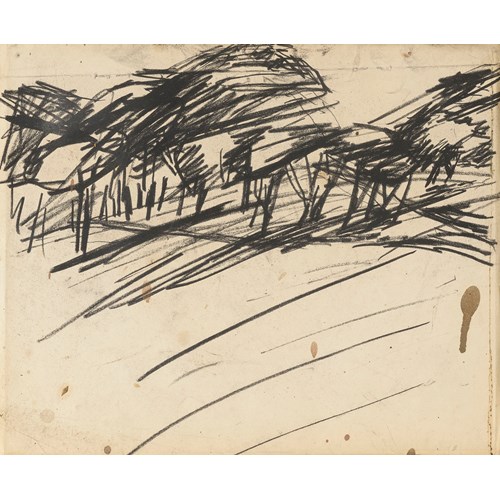Marketplace
Head of the Crowned Virgin
Circle of André Beauneveu
Head of the Crowned Virgin
Date Circa 1400
Dimension 21 x 15 cm (8¹/₄ x 5⁷/₈ inches)
This beautiful, crowned head was once part of a full-length figure of the Virgin, likely to have been holding a Christ child balanced on her knee. One can only imagine how impressive it would have been given the exquisiteness of what survives. Due to its fragmentary nature however, the beauty of this object lies in the serene expression and the naturalistic carving of her face and hair, and moreover, the extraordinary amount of original polychromy and gilding which have survived. It is a remarkable relic of the highpoint of Gothic art production and is certainly one of the finest examples of its type available on the market today.
A pale faced beauty stares out beneath an elaborate crown, her features framed by a veil, which flows down over the back and sides of her head over waves of luxuriant hair – in turn parted at the top of her fashionably high forehead. Large, almond eyes are painted blue with dark pupils. Pink highlights denote the skin of the eyelids, whilst perfectly formed eyebrows sit above. A long slender nose adds further to the image of her as an elegant beauty, sitting above small, pursed lips, and a slightly fuller chin and neck. Her white skin, like porcelain, is highlighted with subtle pink impressions on her cheeks, which, despite her overall unearthly beauty, give just a subtle suggestion of mortal life.
The band of the crown has been carved with a row of geometrical painted shapes representing precious jewels. Above and below this band is a border of decorative beading, realised with fine precision. Surmounted above this are the remains of fleur-de-lys which decorated the exterior of the crown. The Fleur-de-Lys was the symbol associated most closely with France, and with the Virgin Mary, and commonly used by French royalty in heraldry. Due to the intricacy of their carving and their elaborate nature, only one partly intact fleur-de-lys remains. Nevertheless, its intricacy and elaborate carving confirm what a remarkable sculpture this was reflecting an important commission.
The twelfth and thirteenth centuries saw an extraordinary growth of the cult of the Virgin in western Europe, in part inspired by the writings of theologians such as Saint Bernard of Clairvaux (1090–1153). This movement found its grandest expression in the French cathedrals, which are often dedicated to “Our Lady”. During this period, carved depictions of the Virgin Mary abound from the 1300s onward, executed both by artists from modern day Northern France and Southern Netherlands working for the Valois courts of France, including Paris, Berry and Burgundy; with artistic centres in Ile de France, Lorraine and the Loire.
The subject of the Virgin presenting the Child on her left knee can be seen throughout the kingdom of France during the 13th and 14th century and especially in Lorraine and in the Rhine valley. The Marian cult and that of the Virgin and Child saw a renewed interest during the 14th century in such objects from those seeking a new spiritual sensibility and a more intimate religious observance. The lifelike figure, with her gently angled poise, naturalistic features and direct gaze are typical aspects of Southern Netherlandish/Northern French gothic stone carving from this later more naturalistic phase. However, the extreme refinement, and delicate precision of the present carving puts it above other examples, and suggests that it is made by André Beauneveu or someone in his immediate ambit. Beauneveu was one of the leading sculptors of the day, and his commissions were abundant and his influence widespread - leading to him leave a legacy and reputation that remains today, and uncommon for artistic figures of the period.
Fig. 1 and Fig. 2. Virgin and Child, Sainte-Juste, Arbois Church, and detail
Fig. 3 and 4. La Vierge à l’Enfant, of the South Portal of Hal Church, and detail
Our head can be compared favourably with Beauneveu’s Virgin and Child for Sainte-Juste in Arbois, as well as his Virgin at Aynard, however, it is most closely comparable with the example at Hal of a Virgin and Child. The latter has a similar physiognomy, with a long nose and almond shape eyes, and the same decoration in the crown. It is also worth noting an example from Bruges, dated to 1380 (Musée Mayer van den Bergh, inv. MMB.0349) which although of a different sensibility and by a different artist, the format, hair and crown are all comparable, however the differing sensibility serves to highlight quite how remarkably fine and beautiful the present example is.
Fig. 5. and 6. Vierge Aynard, Aynard Church, and detail
Fig.7. Vierge et Enfant, de l’eglise Saint Donatien de Bruges, Bruges, dated to 1380, Musée Mayer van den Bergh, inv. MMB.0349.
With thanks to Paul Williamson for his help in preparing this text.
Date: Circa 1400
Dimension: 21 x 15 cm (8¹/₄ x 5⁷/₈ inches)
Provenance: Daniel Katz Gallery, London, 1990s, by whom acquired by
Private Collection, U.S.A, until 2022
Plus d'œuvres d'art de la Galerie





_T638354709335648178.jpg?width=500&height=500&mode=pad&scale=both&qlt=90&format=jpg)



